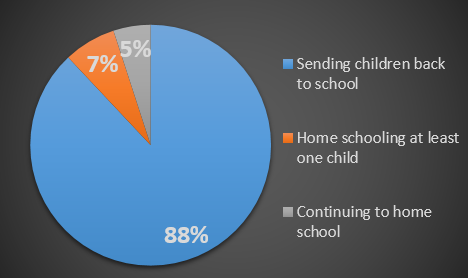Research |

Return to School and COVID-19 (September 2, 2020)
September 2, 2020![]() Click here for a print friendly version of this report
Click here for a print friendly version of this report
Almost 1 in 10 parents not planning to send children to school this September
With just under a week prior to the start of the 2020-21 school year, we asked parents if they plan on sending their children back to school or if they will be home schooling their children. Overall, 88% of parents plan on sending their children back to school this September, while 12% will be home schooling. The 12% includes 7% who had previously been sending their children to school, but are choosing to home school instead. When those who had already been home schooling prior to the pandemic are removed, this increases to 8% of parents who plan to home school this September who had not been home schooling before the pandemic.
When asked what would convince them to send their children back to school in September rather than home schooling, the most common reasons given were related to having additional restrictions in place (most often smaller classroom sizes), having greater clarity from their school division about the policies being implemented related to COVID-19, or guarantees that in-person schooling would continue for the entire year.

Lower income, women, and younger parents most likely to be home schooling
When looking at those who had not been previously home schooling their children prior to the pandemic, results show significant differences between groups. The most noticeable is that parents who are 18 to 29 are about twice as likely as those 30 and older to say they will be home schooling their children. In addition, those in the highest income group ($100,000 or more annually) are very unlikely to be home schooling their children.
These differences are likely due to a number of factors, most likely linked to employment, as those in the highest income households and over 30 are most likely to be employed, and may not be able to home school their children if they wanted.

METHODOLOGY
PRA conducted the survey from August 28 – September 1, 2020, using its Manitoba Panel. In total, 444 Manitobans completed the survey.
Because this sample is a non-probability sample, no error rate can be calculated. A random population survey of this size would yield an error rate of ± 4.6% (19 times out of 20).
As any sample may not represent the population perfectly, PRA corrects statistically for discrepancies in gender, age, and income to ensure that the sample corresponds as closely as possible to Statistics Canada information.
PRA Inc. sponsored these questions independently.
No other organization, public or private, funded this study in whole or in part.
For more information about the research, please contact Nicholas Borodenko, partner, at borodenko@pra.ca
(204) 987-2030 or toll-free at 1-888-877-6744
Recent Posts

Manitobans Express Growing Concern Over Potential US Tariffs and Adjust Habits to Support Local Economy
February 12, 2025Authored by Zia HameedQuestions about the research can be directed to Nicholas Borodenko, borodenko@pra.ca Recently, the United States proposed to impose tariffs on Canada, initially set to be implemented on February 4, 2025. However, a temporary 30-day pause has been agreed upon. A recent survey conducted by PRA Inc. has revealed that Manitobans […]

Non-seatbelt use higher in rural Manitoba, while electronic communication device use higher in Winnipeg: Manitoba Public Insurance
A road safety observation study commissioned last fall by Manitoba Public Insurance reports that non-seatbelt use is higher in rural Manitoba with 10 per cent of all drivers observed not wearing their seatbelt, compared to three per cent in the Winnipeg capital region.
